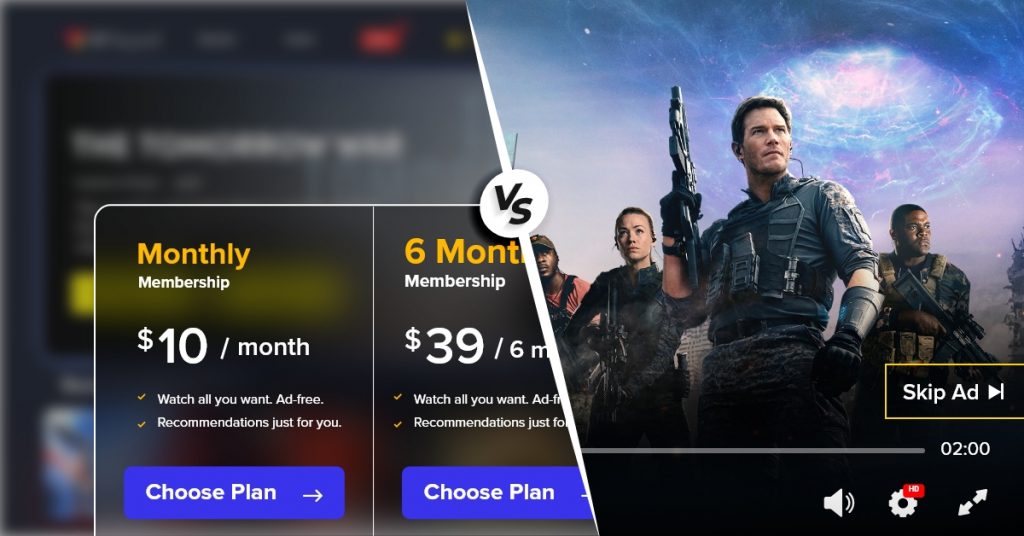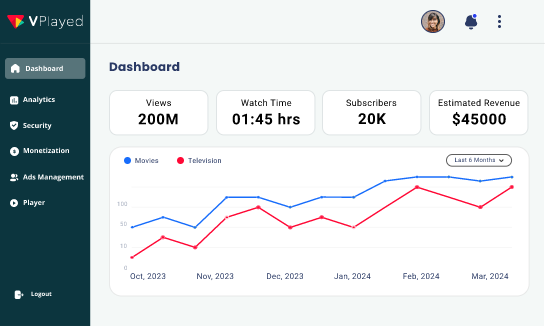SVOD Vs AVOD – The Best Monetization Model For VOD Business?
The Internet has revolutionized how we access video as well as audio content. Gone are the days of switching between TV channels; now, we can actually choose what we want to watch and when to watch from a cataloged list.
The umbrella term for this is VOD Streaming (Video on Demand), and there are multiple revenue models for businesses to choose from if they go down this route. AVOD (Advertising Video on Demand) vs. SVOD (Subscription Video on Demand) are the top two.
In 2020, AVOD experienced significant growth as the market became more competitive, and monthly costs per user dropped lower and lower. More avenues for revenue generation were sought out.
Meanwhile, for SVOD advertising, the market remains as ripe as ever, with its size projected to reach USD 32.3 billion by 2025.
The battle between SVOD and AVOD continues to shape the landscape of the VOD business. With this thing clear, let us look deeper into the dynamics of SVOD vs. AVOD and explore which monetization model stands out as the best choice for your online video streaming venture.
Here’s all you need to know about this popular VOD platform and what to choose for your platform.
Table of Contents
What is SVOD (Subscription Video On Demand)?
Now, keeping the discussion of SVOD Vs AVOD aside, let’s know a bit more about SVOD — It is a popular monetization model for OTT video platforms, standing for Subscription Video on Demand.
It allows users to pay a regular flat fee — either monthly or annually, and, in return, receive unlimited access to a massive catalog of audio or video content for that duration.
This top video monetization model is quite similar to traditional TV packages, but the content is much more curated and can be categorized for niche industries or general audiences.
Additionally, premium video on demand (PVOD) has gained traction as an alternative, allowing users to pay for early or exclusive access to high-value content.
In a simpler and easy to understand way — One can picture it as a Software as a Service (SaaS) subscription, but tailored for online video content.
Benefits of Subscription Video On Demand (SVOD) Model
Now that you are quite familiar with the SVOD model, let us now explore the benefits that the Subscription Video On Demand (SVOD) model offers to OTT video platforms.
1. Predictable and Recurring Revenue
Having fixed rates per user per month or year allows OTT platforms to maintain a stable and predictable amount of revenue each month. This predictability is actually a crucial advantage, providing financial stability and facilitating better long-term planning.
With a clear understanding of the incoming revenue, platforms can strategically invest in content production, platform enhancements, and overall business growth. Overall, the SVOD model creates a consistent cash flow that helps in withstand market fluctuations and uncertainties.
2. Better Profit Margins
Compared to other OTT video monetization models, SVOD allows for higher profit margins with just a few thousand subscribers. The subscription fees contribute directly to the platform’s revenue without relying heavily on ad sales or other sources.
This financial efficiency is especially advantageous for video streaming platforms in their early months, striving for sustainable growth. Indeed, SVOD’s capacity to generate significant revenue from a relatively modest subscriber base positions it as an appealing choice for businesses aiming for profitability without the necessity of a vast user reach.
3. Better Customer Base
By establishing an SVOD subscription models, video platforms can effectively cultivate a more refined and engaged audience compared to offering content for free or employing alternative revenue models in online video platform.
It is evident that subscribers exhibit a sincere interest in the content, demonstrating a willingness to invest in accessing the exclusive offerings.
Moreover, this dedication nurtures a sense of loyalty, granting platforms valuable insights into their audience’s preferences to a much greater extent.
The carefully curated customer base not only enables the customization of content, promotions, and user experience but also contributes to creating a more robust and actively engaged community.
Choose The SVOD Platform Route if…
You want a curated customer base with predictable revenue, and would prefer to keep your platform ad-free and completely in your control.
All in all, The SVOD model empowers businesses to build a sustainable and profitable streaming platform, offering a premium experience to subscribers while maintaining financial stability.
Why is SVOD the Most Profitable VOD Model?
Businesses opting for SVOD monetization generate revenue by offering packaged content through monthly, quarterly, or annual subscriptions, charging customers a recurring fee.
When comparing AVOD vs SVOD, businesses primarily operate on membership plans with varying conceptualizations. Giant media enterprises, such as Netflix, HBO Max, Disney+, Hulu, etc., leverage the SVOD business model.
Statistics indicate that some of the top video entrepreneurs implement subscription-based models, helping them generate an average income of $5,800 each month.

One noteworthy aspect of SVOD that captures attention is that viewers opting for this package can enjoy premium content at their convenience, anywhere and anytime.
They are no longer constrained by programmed schedules or the need to wait for a show to be recorded on their smart box.
Given that these unique content pieces can be accessed with wireless Internet connectivity, users are not restricted to a particular device. Importantly, there is no additional fee for the audience to watch on any type of device.
All these factors play a significant role in cost considerations for viewers, as subscription VODs can be enjoyed at their convenience, often at a lower cost than cable or satellite TV packages.
SVOD Pricing Model
Once you decide to adopt the SVOD business model for your video streaming business, the next step is to determine the pricing plans you will use.
There are several subscription-based video on demand pricing structures available, but you can settle on one of the three options below:
- Explore options with Free trial
A free trial is a brief period during which a user can access your full video library for free. A good percentage of users may choose to sign up after exploring your VOD content and experiencing its fascinating appeal.
Looking To Build Your Own Video Monetization Platform?
Start and Grow Your Video Streaming Service With 1000+ Features & 10+ Revenue Models.
 Highly Customizable
Highly Customizable Life Time Ownership
Life Time Ownership Own 100% of Your Revenue
Own 100% of Your Revenue
 Full-Branding Freedom
Full-Branding Freedom

- Lure Customers with Freemium
Freemium, on the other hand, provides access to your VOD assets that consumers can enjoy for as long as they desire without any charge. Despite offering minimal immediate profitability, this SVOD model can help build an expanded user base.
- Capitalize on Selective Access Model
This model can be advantageous once your business surpasses the initial stage. You can apply it in various combinations, such as offering a specific number of views or downloads per month, access to particular episodes, etc. Initially, you can keep it simple.
Considering SVOD vs AVOD, the choice of pricing model depends on your business goals and audience preferences. Each option has its merits, and the right approach can significantly impact your revenue and user engagement.
What is AVOD (Advertising Video On Demand)?
What does AVOD stand for? AVOD represents ad-based video on demand. In this Over-The-Top (OTT) monetization method, users can access video content for free.
Similar to traditional broadcast television, users are required to endure targeted advertisements to gain access to the content, thereby serving as the primary revenue stream for the OTT platform owner.
YouTube stands out as the most prominent example of AVOD advertising. The revenue generated from ads is strategically utilized to offset production costs, manage the expenses of the best online video hosting platforms, and facilitate content delivery.

Benefits of Ad-supported Video On Demand Monetization Model
AVOD, or Ad-supported Video On Demand, offers several benefits as a monetization model for OTT platforms. Let’s get to know more about it in this part of the blog.
1. Unlimited Videos For Free
When it comes to AVOD, users can enjoy an uninterrupted content viewing experience, accessing as many videos as they wish without incurring any additional fees whatsoever, provided they have the patience to watch all kinds of advertisements. This model offers a free-of-charge avenue for users to explore a diverse range of content.
2. Vast Reach
Video viewing platforms boast vast and diverse audiences that companies can tap into with targeted ads. Advertisers benefit from a broad demographic spectrum, ensuring that their content reaches a wide number of viewers, enhancing the effectiveness of their advertising campaigns.
3. Democratic Viewership
The absence of a regular fee ensures that all content can be accessed by anyone, anywhere. This democratization of viewership increases the reach and popularity of the platform exponentially. AVOD eliminates financial barriers, making content accessible to a global user base.
Opt For an AVOD Platform if..
You would like to promise free video and audio content to your users without creating any sort of OTT subscription model. Nevertheless, choosing an AVOD model allows you to offer content without a regular fee while generating steady revenues through targeted advertising.
This approach appeals to businesses seeking to balance user accessibility and revenue generation.
Choosing Between AVOD Vs SVOD
Both Subscription-supported video on demand and advertising-supported video on demand offer positive avenues for revenue generation. However, when comparing SVOD vs. AVOD, SVOD requires a one-time payment, while AVOD allows users to watch any sort of content for free.

That said, your choice between the two (AVOD Vs SVOD) would totally depend on your VOD business model and the following factors:
- Type of content
- Advertising landscape
- Audience demographics
- Content fees and licenses
- Investments in platform and content management systems
- Financial goals per month and year
The Importance of Choosing The Right VOD Revenue Model
Revenue models must seamlessly integrate with a multi-device, web-powered ecosystem accessed by thousands of users simultaneously. They need to prioritize security and confidentiality, instantly granting user access upon payment.
Subscription-based video streaming platforms experiencing delays risk a high customer churn rate.
The perks of choosing monetization
Regardless of whether you are leaning towards Advertising Video on Demand (AVOD) or Subscription Video on Demand (SVOD), opting and implementing a monetization model in general offers a number of advantages. Some of the benefits are listed below.
- Steady Revenue: Monetization plans provide a consistent flow of revenue, ensuring coverage for operational and maintenance costs, while also contributing to profits. This financial stability supports sustainable growth and quality content production.
- Secure Content: Introducing paywalls enhances the overall content security, thereby reducing the risk of piracy to a much greater extent. Monetization ensures that the content creators or content owners are compensated well for their work, creating a more secure and sustainable digital environment.
- Privacy: Subscriptions, a key component of SVOD, offer exclusivity and privacy for users. Subscribers can curate their watchlist, enjoying a personalized viewing experience without compromising much on the privacy part. Furthermore, this enhances user satisfaction and loyalty.
- Flexible Monetization: OTT platform providers can tailor the monetization plans based on the content that the creator is providing to the end user. Keeping generic content accessible for free while securing premium content through subscriptions or targeted ads allows for a flexible and user-friendly approach. This flexibility caters to diverse audience preferences and content genres
____________________________________________________________________
✨ Read Also: 9+ Best SVOD Solutions to Launch Video Subscription Platform✨
___________________________________________________________________
How Does VOD Help in Generating Revenues?
Firstly, the demand for video on demand is at an all-time high! So you’d be stepping into a very lucrative industry with the help of the world’s best video-on-demand solution providers. Many businesses have built their brands as a top successful VOD platform, using steady revenues to learn what is vod.
This is achieved by incorporating various monetization models to fund their operations. It is flexible and scalable enough to support thousands of content pieces with millions of users simultaneously.
Conclusion
Creating an effective video monetization platform is a smart move that goes beyond just providing content. It ensures that you can deliver great content to a carefully selected group of users while also keeping a steady income and growing your successes.
However, the key is picking the right way to make money from your videos that match what you want for your business and what your viewers like.
As you enter the world of Video on Demand, understanding the importance of making money from your videos is essential for your platform to keep being successful. The ever-changing world of VOD needs you to be flexible, creative, & committed to meeting what your users want.
By using VOD, you are not only getting into a profitable industry but also playing a part in the growing world of digital content consumption.
If you Already Have an Idea About Launching a Video Monetization Platform, Schedule a Free Demo and We’ll Get You On The Road To VOD Streaming Success!
Frequently Asked Questions(FAQ):
AVOD, or Advertising Video on Demand, works around providing free, ad-supported content, offering an alternative revenue stream. Typically available at no cost to end-users, this model, despite generating lower profitability compared to SVOD and others, compensates through ad revenues to cover content preparation and hosting costs.
At present, businesses strategically leverage a combination of monetization models (HVOD), leveraging both sides of the coin. For instance, consider an audience subscribing to a package of premium content, coupled with an additional fee for non-skippable ads. This hybrid approach proves lucrative, tapping into multiple revenue streams effectively.
SVOD, or Subscription Video on Demand works in a way that it allows users to access the entire video library for a defined period through subscription-based recurring payments. This flexible model ensures that the users can enjoy videos on any device with a robust Internet connection.
When looking at the differences — AVOD vs SVOD, the revenue models differ significantly. AVOD relies on the number of views generated through instream ads for revenue. While the SVOD model provides recurring revenue with additional benefits. The fundamental distinction lies in their revenue generation mechanisms, despite other contributing factors.
When considering video streaming business, SVOD vs AVOD stand as crucial monetization models, providing substantial support. Content providers can offer consumers monthly, quarterly, or annual subscriptions, aligning with the popular streaming model. Simultaneously, incorporating numerous content libraries supported by instream ads, companion ads, and skippable/non-skippable ads contributes to doubling streaming revenue effectively.

